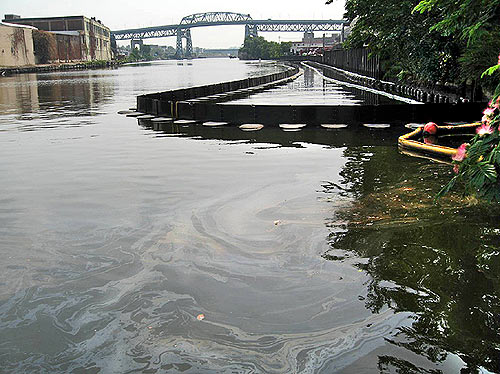An underground oil spill that has been leaking toxic vapors into Greenpoint air since the 1950s is almost twice as large as once thought, a bombshell report revealed last week week.
The Environmental Protection Agency study put the size of the spill at 30 million gallons, or three times the size of the 1989 Exxon Valdez disaster — and said that it will take more than three decades to clean up the damage at the rate at which ExxonMobil is currently scrubbing.
The global energy giant has been sued by state Attorney General Andrew Cuomo for the leisurely approach to cleaning up the toxic goo, which was discovered underneath a wide swath of northeastern Greenpoint in 1978, though it dates back far deeper into the area’s industrial past.
Homeowners have also filed two class-action lawsuits and environmental groups have another, though the EPA report did not discuss whether the spill has caused, as some plaintiffs claim, rare blood cancers and leukemia.
“Chemicals were detected [in a wide area], but not in a pattern that would typically represent a vapor intrusion phenomenon,” the report stated.
But Rep. Anthony Weiner (D–Sheepshead Bay), who released the EPA report with Rep. Nydia Velazquez (D–Williamsburg) last Friday, wasn’t buying it.
“Finally, the public has gotten some answers to its questions about the effects [of] this oil spill, but they deserve more,” he said. “Hundreds of homes and businesses are affected. We will not stop pressing the issue until residents are fully informed of all the health risks and the remediation process has been expedited.”
Other plaintiffs want compensation for property damages and decreased land value.
Yet despite this latest round of attention, not everyone in Greenpoint is aware that the neighborhood is atop a leaking bowl of Texas tea.
A Brooklyn Paper reporter who inquired whether an apartment on Hausman Street — near the center of the spill — was in the danger zone was told by a real estate agent from Aptandlofts.com, “I don’t think so.”
“That’s more around the Greenpoint and Williamsburg border,” the agent said.
Hausman Street has become a symbol of the neighborhood’s conflicted feelings about the spill. Even though every house on the block flies an American flag — a tribute to a neighbor who was killed on 9-11 — there is certainly no unity about the contamination from the largest oil spill in American history.
Block association President Bob McErlean is one of the most outspoken plaintiffs in Greenpoint Residents v. Exxon. But a neighboring family, the Flynns, doesn’t want to think about it.
The family has been living on the block for almost a century, but Catherine Flynn, the matriarch, didn’t even try to get the results of testing that “some men from Germany” did a few years ago.
Her sons are hard-working men without a litigious bone in their bruised bodies. Frank Flynn became disabled after 800 pounds fell on him in his shipping job, but he never sued the company he worked for, even though the incident made him unemployable.
“The oil has been here before we were around, and it’ll be here after,” Catherine’s daughter, Eileen Flynn, said matter-of-factly.
At the same time, the younger generation that has discovered the cheap rents of Greenpoint is not invested enough — or is just too transient — to care.
“I wouldn’t want to raise a family here,” says Karen Santos-da Silva, a New York University student who moved to Nassau Street two years ago.
For its part, ExxonMobil spokesman Barry Wood said the company had “accepted responsibility” for the spill and would “be in Greenpoint until the job is done and the job is done right.”
But people like Santos-da Silva will be long gone by the expected date of completion of the cleanup — in 2026.
She told The Brooklyn Paper that she’ll move away from the spill zone after she graduates from college next year.



















